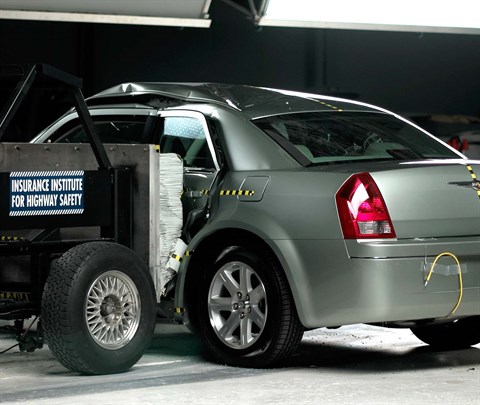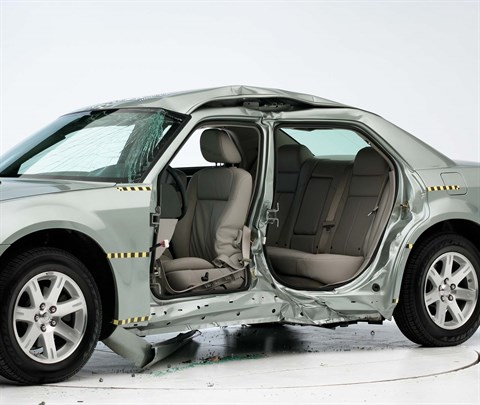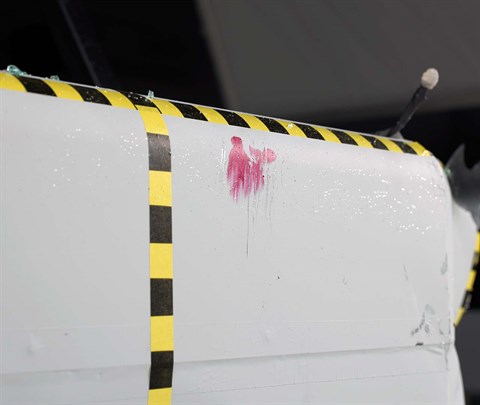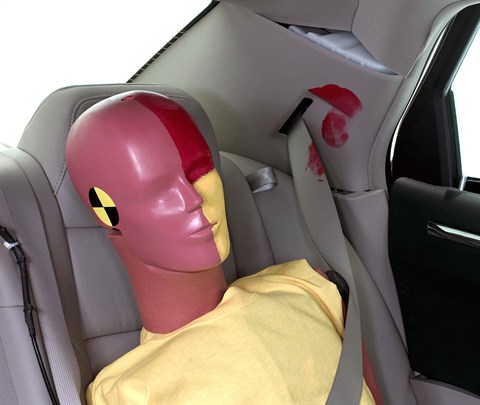Moderate overlap front: original test
Rating applies to 2005-10 models
Tested vehicle: 2005 Chrysler 300 Touring 4-door
The Chrysler 300 was introduced in the 2005 model year, and the Dodge Charger was introduced in the 2006 model year.
The moderate overlap frontal crash test ratings also apply to the station wagon version of the 300 and Charger: 2005-08 models of the Dodge Magnum (discontinued after the 2008 model year).
| Evaluation criteria | Rating |
|---|---|
| Overall evaluation | |
| Structure and safety cage | |
| Driver injury measures | |
| Head/neck | |
| Chest | |
| Leg/foot, left | |
| Leg/foot, right | |
| Driver restraints and dummy kinematics | |

Action shot taken during the frontal offset crash test.

The dummy's position in relation to the steering wheel and instrument panel after the crash test indicates that the driver's survival space was maintained well.

Dummy movement was well controlled. During rebound, the dummy's head hit only the head restraint.

Intrusion into the driver's space was minimal, and all leg and foot injury measures were low.
Measures of occupant compartment intrusion on driver side
| Evaluation criteria | Measurement |
|---|---|
| Test ID | CEF0518 |
| Footwell intrusion | |
| Footrest (cm) | 11 |
| Left (cm) | 10 |
| Center (cm) | 9 |
| Right (cm) | 6 |
| Brake pedal (cm) | 3 |
| Instrument panel rearward movement | |
| Left (cm) | 0 |
| Right (cm) | 1 |
| Steering column movement | |
| Upward (cm) | 0 |
| Rearward (cm) | 0 |
| A-pillar rearward movement (cm) | 0 |
Driver injury measures
| Evaluation criteria | Measurement |
|---|---|
| Test ID | CEF0518 |
| Head | |
| HIC-15 | 149 |
| Peak gs at hard contact | no contact |
| Neck | |
| Tension (kN) | 1.1 |
| Extension bending moment (Nm) | 14 |
| Maximum Nij | 0.30 |
| Chest maximum compression (mm) | 34 |
| Legs | |
| Femur force - left (kN) | 0.5 |
| Femur force - right (kN) | 1.0 |
| Knee displacement - left (mm) | 0 |
| Knee displacement - right (mm) | 0 |
| Maximum tibia index - left | 0.24 |
| Maximum tibia index - right | 0.50 |
| Tibia axial force - left (kN) | 1.1 |
| Tibia axial force - right (kN) | 1.5 |
| Foot acceleration (g) | |
| Left | 47 |
| Right | 61 |
Side: original test
Rating applies to 2005-07 models
Tested vehicle: 2006 Chrysler 300 Touring 4-door with optional front and rear side curtain airbags
The Chrysler 300 was introduced in the 2005 model year, and the Dodge Charger was introduced in the 2006 model year.
Two tests of the 300 were conducted, one with an optional side curtain airbag for the driver and rear passenger, and one without. These vehicles are rated separately, except that the structural ratings for both vehicles are based on both tests.
In 2008-09 models, optional side airbags designed to protect drivers' and front passengers' torsos were added to the optional side curtain airbags previously available; therefore the earlier test ratings with optional side airbags do not apply to 2008-09 models. (With torso protection, the side test rating could improve, but the Institute did not test this configuration.) The side torso airbags were dropped in the 2010 models, and the side curtain airbags were made standard.
| Evaluation criteria | Rating |
|---|---|
| Overall evaluation | |
| Structure and safety cage | |
| Driver injury measures | |
| Head/neck | |
| Torso | |
| Pelvis/leg | |
| Driver head protection | |
| Rear passenger injury measures | |
| Head/neck | |
| Torso | |
| Pelvis/leg | |
| Rear passenger head protection | |

View of the vehicle and barrier just after the crash test.

View of the vehicle after the crash with doors removed, showing the side airbag and damage to the occupant compartment.

Action shot taken during the side impact crash test showing the driver dummy's head was protected from being hit by hard structures by the side curtain airbag.

Smeared greasepaint shows where the rear passenger dummy’s head was protected by the side airbag.
Measures of occupant compartment intrusion on driver side
| Test ID | CES0614 | CES0615 |
|---|---|---|
| B-pillar to longitudinal centerline of driver's seat (cm) | -6.0 | -5.5 |
| Negative numbers indicate the amount by which the crush stopped short of the seat centerline. | ||
Driver injury measures
| Evaluation criteria | Measurement |
|---|---|
| Test ID | CES0614 |
| Head HIC-15 | 380 |
| Neck | |
| Tension (kN) | 1.1 |
| Compression (kN) | 0.4 |
| Shoulder | |
| Lateral deflection (mm) | 63 |
| Lateral force (kN) | 3.2 |
| Torso | |
| Maximum deflection (mm) | 65 |
| Average deflection (mm) | 46 |
| Maximum deflection rate (m/s) | 9.07 |
| Maximum viscous criterion (m/s) | 1.85 |
| Pelvis | |
| Iliac force (kN) | 2.9 |
| Acetabulum force (kN) | 3.2 |
| Combined force (kN) | 5.9 |
| Left femur | |
| L-M force (kN) | 0.6 |
| L-M moment (Nm) | 128 |
| A-P moment (Nm) | 48 |
Passenger injury measures
| Evaluation criteria | Measurement |
|---|---|
| Test ID | CES0614 |
| Head HIC-15 | 58 |
| Neck | |
| Tension (kN) | 0.1 |
| Compression (kN) | 0.5 |
| Shoulder | |
| Lateral deflection (mm) | 19 |
| Lateral force (kN) | 0.9 |
| Torso | |
| Maximum deflection (mm) | 19 |
| Average deflection (mm) | 14 |
| Maximum deflection rate (m/s) | 2.27 |
| Maximum viscous criterion (m/s) | 0.23 |
| Pelvis | |
| Iliac force (kN) | 1.5 |
| Acetabulum force (kN) | 0.7 |
| Combined force (kN) | 2.1 |
| Left femur | |
| L-M force (kN) | 0.4 |
| L-M moment (Nm) | 80 |
| A-P moment (Nm) | 35 |
Rating applies to 2005-09 models
Tested vehicle: 2006 Chrysler 300 Touring 4-door without optional side airbags
The Chrysler 300 was introduced in the 2005 model year, and the Dodge Charger was introduced in the 2006 model year.
Two tests of a 2006 model 300 were conducted, one with an optional side curtain airbag for the driver and rear passenger, and one without. These vehicles are rated separately, except that the structural ratings for both vehicles are based on both tests.
In 2008-09 models, optional side airbags designed to protect drivers' and front passengers' torsos were added to the optional side curtain airbags previously available; therefore the earlier test ratings with optional side airbags do not apply to 2008-09 models. (With torso protection, the side test rating for 2008-09 models so equipped could improve, but the Institute did not test this configuration.)
In the 2010 models, the side curtain airbags were made standard; therefore these ratings without side airbags do not apply to 2010 models.
| Evaluation criteria | Rating |
|---|---|
| Overall evaluation | |
| Structure and safety cage | |
| Driver injury measures | |
| Head/neck | |
| Torso | |
| Pelvis/leg | |
| Driver head protection The dummy's head was hit by the intruding barrier. This hit did not produce high head injury measures, but head impacts with intruding objects such as other vehicles, trees, and poles should be prevented. |
|
| Rear passenger injury measures | |
| Head/neck | |
| Torso | |
| Pelvis/leg | |
| Rear passenger head protection The dummy's head was hit by the pillar behind the rear passenger door. This pillar is required by federal standard to provide some protection for occupants' heads. |
|

View of the vehicle and barrier just after the crash test.

View of the vehicle after the crash with doors removed, showing the damage to the occupant compartment.

Smeared greasepaint and scrape marks indicate where the driver dummy's head hit the barrier.

Smeared greasepaint shows where the rear passenger dummy's head was hit by the pillar behind the rear passenger door.
Measures of occupant compartment intrusion on driver side
| Test ID | CES0614 | CES0615 |
|---|---|---|
| B-pillar to longitudinal centerline of driver's seat (cm) | -6.0 | -5.5 |
| Negative numbers indicate the amount by which the crush stopped short of the seat centerline. | ||
Driver injury measures
| Evaluation criteria | Measurement |
|---|---|
| Test ID | CES0615 |
| Head HIC-15 | 608 |
| Neck | |
| Tension (kN) | 2.0 |
| Compression (kN) | 0.1 |
| Shoulder | |
| Lateral deflection (mm) | 63 |
| Lateral force (kN) | 2.9 |
| Torso | |
| Maximum deflection (mm) | 67 |
| Average deflection (mm) | 47 |
| Maximum deflection rate (m/s) | 7.34 |
| Maximum viscous criterion (m/s) | 1.96 |
| Pelvis | |
| Iliac force (kN) | 4.7 |
| Acetabulum force (kN) | 3.5 |
| Combined force (kN) | 8.3 |
| Left femur | |
| L-M force (kN) | 0.5 |
| L-M moment (Nm) | 110 |
| A-P moment (Nm) | 34 |
Passenger injury measures
| Evaluation criteria | Measurement |
|---|---|
| Test ID | CES0615 |
| Head HIC-15 | 327 |
| Neck | |
| Tension (kN) | 0.4 |
| Compression (kN) | 1.2 |
| Shoulder | |
| Lateral deflection (mm) | 19 |
| Lateral force (kN) | 0.9 |
| Torso | |
| Maximum deflection (mm) | 33 |
| Average deflection (mm) | 22 |
| Maximum deflection rate (m/s) | 3.84 |
| Maximum viscous criterion (m/s) | 0.54 |
| Pelvis | |
| Iliac force (kN) | 1.8 |
| Acetabulum force (kN) | 1.0 |
| Combined force (kN) | 2.6 |
| Left femur | |
| L-M force (kN) | 0.2 |
| L-M moment (Nm) | 62 |
| A-P moment (Nm) | 29 |
Head restraints & seats
Seat type: Manual leather seat
| Overall evaluation | |
|---|---|
| Dynamic rating | |
| Seat/head restraint geometry |
| Seat type | Manual leather seat |
|---|---|
| Geometry | |
| Backset (mm) | 35 |
| Distance below top of head (mm) | 52 |
| Seat design parameters | |
| Pass/fail | Pass |
| Max T1 acceleration (g) | 13.7 |
| Head contact time (ms) | 59 |
| Force rating | 3 |
| Neck forces | |
| Max neck shear force (N) | 198 |
| Max neck tension (N) | 1,045 |
About the head restraint & seat test
Currently, IIHS tests apply only to front seats.
